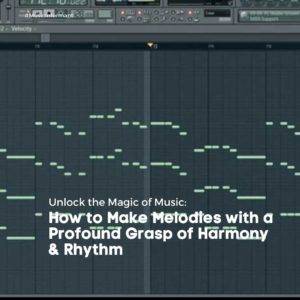
What is parallel compression in music production?
Parallel compression is a technique where multiple tracks of audio are compressed at the same time.
The software can do this by compressing each track individually and then summing the resulting signals or using a hardware compressor with multiple channels.
- Used to add extra sustain to instruments or to make drums more aggressive.
- One of the most commonly used techniques in modern music production.
How do you set up parallel compression?
There are a few different ways to set up parallel compression, but one of the most common is to use multiple audio tracks and compress them simultaneously. The software can do this by compressing each track individually and then summing the resulting signals or using a hardware compressor with multiple channels. Another way to set up parallel compression is to use a single track and compress it multiple times with different settings.
When to use parallel compression?
1. If your computer has multiple cores, using parallel compression can help you take advantage of those cores and speed up the compression process.
2. If your computer is running low on memory, parallel compression can help free up some space by using multiple cores to compress the file simultaneously.
3. Whether or not parallel compression will be effective depends on the compressed file type and the settings you use.
If you’re unsure whether or not to use parallel compression, it’s always best to try it out and see how it affects the compression rate for your specific file.
Parallel compression vs dry/wet?

Problem: When it comes to compression, there are many options. So, what’s the difference between parallel and dry/wet compression?
Agitate: Parallel and dry/wet compression are two types used when compressing files.
Parallel compression uses multiple cores on your computer to compress the file simultaneously,
while dry/wet compression compresses the file using either all wet or all dry processing.
Solution: The type of compression you should be using depends on the compressed file and the settings you use.
What is the difference between lossy and lossless compression?
Lossy and lossless compression are two different ways of compressing files. Lossy compression removes some of the data from the file, while lossless compression compresses the file without removing any data.
Compressing an image, you might want to use lossy compression so that the file size is smaller, but if you’re compressing a text document, you might want to use lossless compression so that all of the data is retained.
Is parallel compression better?
Parallel compression can be faster than compression with a single core, but the difference depends on the file type and settings used. Sometimes resulting in a slower compression rate. If you’re unsure whether or not to use parallel compression, it’s always best to try it out and see how it affects the compression rate for your specific file.
What is one of the benefits of using parallel compression?
One of the benefits of using parallel compression is that it can speed up the compression process.
Standard benefits:
- – Speed up the compression process.
- – Use multiple cores on your computer to compress the file simultaneously.
Emotional benefits:
- – Compress files faster than ever before.
1176 parallel compression settings?
1176 is a popular compressor that can be used for parallel compression. The settings you use will depend on the compressed file type and the quality you want. For example, if you’re compressing an image, you might want to use a higher ratio and a lower threshold to get a more aggressive compression. If you’re compressing a text document, you might want to use a lower ratio and a higher threshold to retain more of the original data.
Answer: For parallel compression with the 1176 compressor, try a ratio of 4:1 and a threshold of -10dB
Should you parallel compress vocals?
Yes, parallel compression can be a great way to make vocals sound more aggressive and in your face. It’s one of the most commonly used techniques in modern music production, and it’s a great way to add extra sustain to vocals or make them sound more punchy.
1176 parallel compression vocal settings?
If you’re compressing vocals, you might want to use a higher ratio and a lower threshold to get a more aggressive compression. You might also want to use a slower attack time and a longer release time to make the compression more subtle. Play the settings and see what sounds best for your particular vocal track.
For parallel compression with the 1176 compressor, try a ratio of 4:1 and a threshold of -10dB.
How much does parallel compression reduce?
Parallel compression can reduce the file size by up to 50%. It depends on the compressed file type and the settings you use. For some files, parallel compression can result in a slower compression rate. If you’re unsure whether or not to use parallel compression, it’s always best to try it out and see how it affects the compression rate for your specific file.
How do I set parallel compressions in Logic?
In Logic, you can set up parallel compression by compressing each track individually and then summing the resulting signals. To do this:
- Insert a compressor on each track you want to compress.
- Set the ratio and threshold for each compressor according to your desired sound.
- Go to the mixer and create a new Bus.
- Send the signal from each compressor to the Bus, and then route the Bus to the main output.
- Adjust the levels of each track until you get the sound you’re looking for.
How do I set up parallel compression in Studio One, Pro Tools & Logic?
In Studio One, you can set up parallel compression by compressing each track individually and then summing the resulting signals. To do this:
- Insert a compressor on each track you want to compress.
- Set the ratio and threshold for each compressor according to your desired sound.
- Go to the mixer and create a new Bus.
- Send the signal from each compressor to the Bus, and then route the Bus to the main output.
- Adjust the levels of each track until you get the sound you’re looking for.
How do you use parallel compression in mastering?
Parallel compression is a technique that can be used in mastering to add extra sustain to your mix or make it sound more aggressive and in your face.
It’s one of the most commonly used techniques in modern music production, and it’s a great way to improve the overall sound of your track.
There are a few different ways to set up parallel compression, but one of the most common is to use multiple audio tracks and compress them simultaneously. The software can do this by compressing each track individually and then summing the resulting signals or using a hardware compressor with multiple channels. Another way to set up parallel compression is to use a single track and compress it multiple times with different settings.
In Logic:
- Insert a compressor on each track you want to compress.
- Set the ratio and threshold for each compressor according to your desired sound.
- Go to the mixer and create a new Bus.
- Send the signal from each compressor to the Bus, and then route the Bus to the main output.
- Adjust the levels of each track until you get the sound you’re looking for.
In Studio One:
- Insert a compressor on each track you want to compress.
- Set the ratio and threshold for each compressor according to your desired sound.
- Go to the mixer and create a new Bus.
- Send the signal from each compressor to the Bus, and then route the Bus to the main output.
- Adjust the levels of each track until you get the sound you’re looking for.
No matter which DAW you’re using, parallel compression is a great way to add extra sustain, depth, and aggressiveness to your mix. Experiment with different settings and plugins until you find a sound you like. And don’t forget to check out our other articles on mixing and mastering for more tips and tricks.
Does parallel compression cause a phase?
Parallel compression can cause a phase difference between the signals that are being compressed. This is because the signals are being compressed at different times, and this can cause them to be out of sync with each other. However, most modern DAWs have built-in tools to help correct this phase difference, so it’s not usually a problem. If you’re having trouble getting your tracks to sound cohesive, try using parallel compression and see if it helps.
How do 2 compressors work vocals?
Compressors are used to control the dynamic range of a signal. They do this by reducing the level of the signal’s peaks and valleys, making it less dynamic. This results in a more consistent sound less likely to overload or distort.
When using two compressors on vocals, you can achieve different effects by adjusting the settings on each compressor.
For example, you can use one compressor to control the dynamics and another to add different colouration or saturation. You can create a unique sound perfect for your mix by experimenting with different combinations of compressors and settings.
What is the difference between a limiter and a compressor?
A limiter is a compressor used to prevent the signal from exceeding a certain threshold.
This threshold is known as the “ceiling.” A limiter is typically used to protect against clipping and distortion.
A compressor, on the other hand, is used to control the dynamic range of a signal.
It does this by reducing the level of the peaks and valleys in the signal, which makes it less dynamic. This results in a more consistent sound less likely to overload or distort.
Limers and compressors can achieve similar effects, but they are typically used for different purposes.
Limiters are usually used to protect against clipping and distortion, while compressors control the dynamic range of a signal.
Parallel compression pre or post-fader?
Parallel compression can be done either pre or post-fader. Pre-fader parallel compression sends the uncompressed signal directly to the main output, while post-fader parallel compression sends the compressed signal to the main output. This can be a useful way to control the levels of the compressed signal.
If you’re unsure which method to use, try both and see which one sounds best for your particular track. Experiment with different settings and plugins until you find a sound you like. And don’t forget to check out our other articles on mixing and mastering for more tips and tricks.
Does parallel compression drum FL Studio?
Yes, parallel compression can be used on drums in FL Studio. You can achieve various effects by adjusting the settings on each compressor. You can create a unique sound perfect for your mix by experimenting with different combinations of compressors and settings.
What is the best parallel compression plugin?
There are various parallel compression plugins available, and it depends on your preferences as to which one is the best. Some popular options include Waves C6, UAD Precision Limiter, and Fabfilter Pro-C 2. Experiment with different plugins and see which one sounds best for your particular track. And don’t forget to check out our other articles on mixing and mastering for more tips and tricks.
Upward compression vs downward compression?
Upward compression increases the level of the quieter signals and reduces the level of the louder signals. This results in a more consistent sound less likely to overload or distort.
Downward compression decreases the level of the louder signals and increases the level of the quieter signals. This results in a more consistent sound less likely to overload or distort.
What is the difference between upward and downward compression?
Both upward and downward compression can achieve similar effects, but they are typically used for different purposes.
Upward compression is usually used to even out the levels of a track, while downward compression is used to control the dynamic range of a signal.
Whatever you use will ultimately depend on your preferences and what sounds best for your particular track. Experiment with different settings and plugins until you find a sound you like. And don’t forget to check out our other articles on mixing and mastering for more tips and tricks.
FabFilter upward compression?
FabFilter offers various compression plugins, and their upward compression plugin is a popular option. It can be used to achieve various effects, and it’s perfect for tracks that need to be more consistent in terms of level. You can create a perfect sound for your mix by experimenting with different settings.
Best upward compressor plugin?
Various plugins are available for upward compression, and it depends on your preferences as to which one is the best. Some popular options include Waves C6, UAD Precision Limiter, and Fabfilter Pro-C 2. Experiment with different plugins and see which one sounds best for your particular track. And don’t forget to check out our other articles on mixing and mastering for more tips and tricks.
Conclusion
This article looks at the different types of compression and when they might be best used. We’ve also discussed using parallel compression to achieve unique sounds in your mixes. You can create a perfect sound for your track by experimenting with different settings and plugins. And don’t forget to check out our other articles on mixing and mastering for more tips and tricks.









